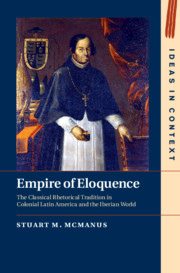 Empire of Eloquence
Empire of Eloquence Published online by Cambridge University Press: 09 April 2021
Chapter 1 argues that the foundations of an Iberian “Empire of Eloquence” were laid in the sixteenth century by the simultaneous expansion of humanist intellectual and educational traditions. This chapter takes the form of a case study of the Valley of Mexico placed within the context of an emerging Iberian World. As well as offering a thumbnail sketch of the Iberian World circa 1550, it makes the case for significant continuity or at least parallels across the pre-/post-Conquest divide. The colleges where classical rhetoric was taught were often built on the site of earlier indigenous institutions, while Renaissance rhetoric and oratory replaced similar indigenous forms of social ordering, most notably Nahuatl huehuetlatolli (“ceremonial speeches”).
To save this book to your Kindle, first ensure [email protected] is added to your Approved Personal Document E-mail List under your Personal Document Settings on the Manage Your Content and Devices page of your Amazon account. Then enter the ‘name’ part of your Kindle email address below. Find out more about saving to your Kindle.
Note you can select to save to either the @free.kindle.com or @kindle.com variations. ‘@free.kindle.com’ emails are free but can only be saved to your device when it is connected to wi-fi. ‘@kindle.com’ emails can be delivered even when you are not connected to wi-fi, but note that service fees apply.
Find out more about the Kindle Personal Document Service.
To save content items to your account, please confirm that you agree to abide by our usage policies. If this is the first time you use this feature, you will be asked to authorise Cambridge Core to connect with your account. Find out more about saving content to Dropbox.
To save content items to your account, please confirm that you agree to abide by our usage policies. If this is the first time you use this feature, you will be asked to authorise Cambridge Core to connect with your account. Find out more about saving content to Google Drive.